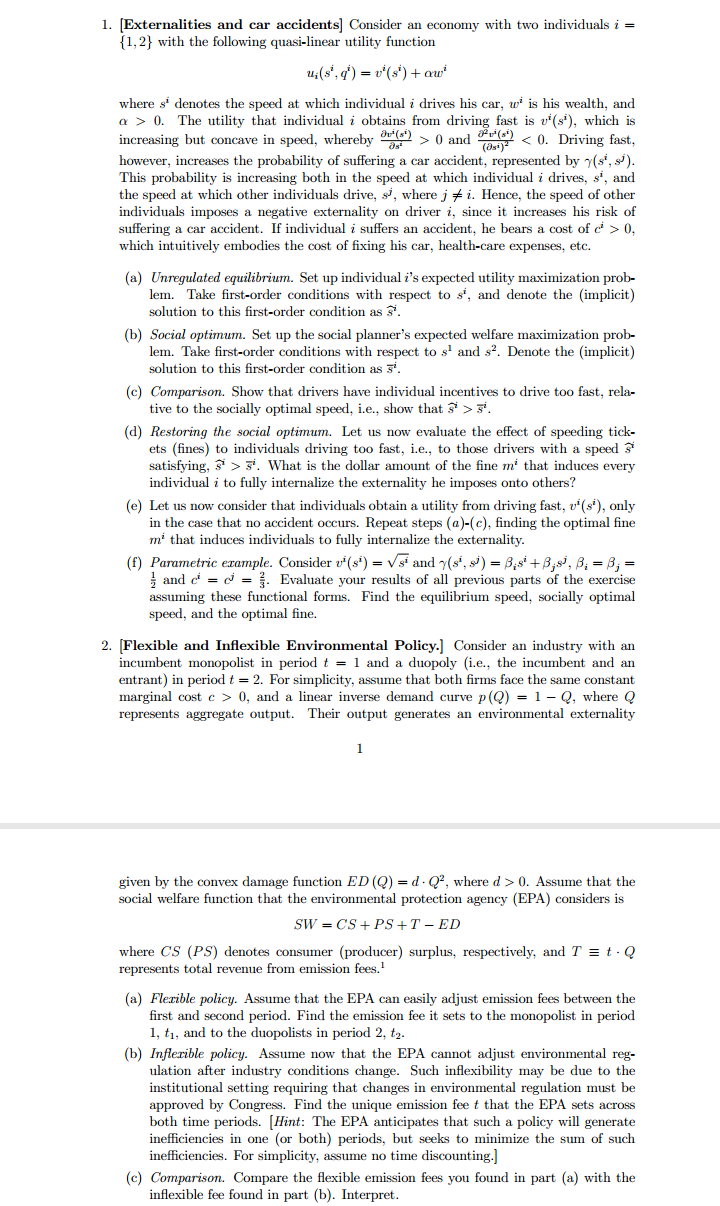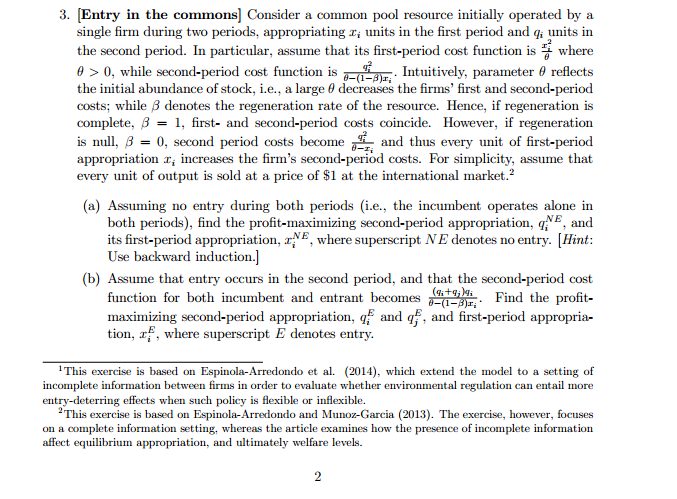


Explain the following
1. [Externalities and car accidents] Consider an economy with two individuals i = [1, 2) with the following quasi-linear utility function uj(s', q') = v'(s') + ow where s' denotes the speed at which individual i drives his car, w is his wealth, and a > 0. The utility that individual i obtains from driving fast is v'(s'), which is increasing but concave in speed, whereby a, > , art(6) > 0 and (8517 (8si) 0, which intuitively embodies the cost of fixing his car, health-care expenses, etc. (a) Unregulated equilibrium. Set up individual i's expected utility maximization prob- lem. Take first-order conditions with respect to s', and denote the (implicit) solution to this first-order condition as 3'. (b) Social optimum. Set up the social planner's expected welfare maximization prob- lem. Take first-order conditions with respect to s' and s'. Denote the (implicit) solution to this first-order condition as 3'. (c) Comparison. Show that drivers have individual incentives to drive too fast, rela- tive to the socially optimal speed, i.e., show that S' > 5'. (d) Restoring the social optimum. Let us now evaluate the effect of speeding tick- ets (fines) to individuals driving too fast, i.e., to those drivers with a speed S' satisfying, s' > 3'. What is the dollar amount of the fine m' that induces every individual i to fully internalize the externality he imposes onto others? (e) Let us now consider that individuals obtain a utility from driving fast, v'(s'), only in the case that no accident occurs. Repeat steps (a)-(c), finding the optimal fine m' that induces individuals to fully internalize the externality. (f) Parametric example. Consider v'(s') = vs and y(s', s') = B;s' + Bjs', B; = B; = and c' = ci = . Evaluate your results of all previous parts of the exercise assuming these functional forms. Find the equilibrium speed, socially optimal speed, and the optimal fine. 2. [Flexible and Inflexible Environmental Policy.] Consider an industry with an incumbent monopolist in period t = 1 and a duopoly (i.e., the incumbent and an entrant) in period t = 2. For simplicity, assume that both firms face the same constant marginal cost c > 0, and a linear inverse demand curve p (Q) = 1 -Q, where Q represents aggregate output. Their output generates an environmental externality given by the convex damage function ED (Q) = d . Q', where d > 0. Assume that the social welfare function that the environmental protection agency (EPA) considers is SW = CS + PS +T - ED where CS (PS) denotes consumer (producer) surplus, respectively, and T = t . Q represents total revenue from emission fees. (a) Flexible policy. Assume that the EPA can easily adjust emission fees between the first and second period. Find the emission fee it sets to the monopolist in period 1, t1, and to the duopolists in period 2, t2. (b) Inflexible policy. Assume now that the EPA cannot adjust environmental reg- ulation after industry conditions change. Such inflexibility may be due to the institutional setting requiring that changes in environmental regulation must be approved by Congress. Find the unique emission fee t that the EPA sets across both time periods. [Hint: The EPA anticipates that such a policy will generate inefficiencies in one (or both) periods, but seeks to minimize the sum of such inefficiencies. For simplicity, assume no time discounting.] (c) Comparison. Compare the flexible emission fees you found in part (a) with the inflexible fee found in part (b). Interpret.3. [Entry in the commons] Consider a common pool resource initially operated by a single firm during two periods, appropriating r, units in the first period and q; units in the second period. In particular, assume that its first-period cost function is + where 0 >0, while second-period cost function is 2-(1-8); ' . Intuitively, parameter 0 reflects the initial abundance of stock, i.e., a large / decreases the firms' first and second-period costs; while / denotes the regeneration rate of the resource. Hence, if regeneration is complete, B = 1, first- and second-period costs coincide. However, if regeneration is null, 3 = 0, second period costs become gy, and thus every unit of first-period appropriation r, increases the firm's second-period costs. For simplicity, assume that every unit of output is sold at a price of $1 at the international market.- (a) Assuming no entry during both periods (i.e., the incumbent operates alone in both periods), find the profit-maximizing second-period appropriation, q, its first-period appropriation, INE, where superscript NE denotes no entry. [Hint: Use backward induction.] (b) Assume that entry occurs in the second period, and that the second-period cost function for both incumbent and entrant becomes a-(1-8);' (atsini . Find the profit- maximizing second-period appropriation, of and q, and first-period appropria- tion, re , where superscript E denotes entry. This exercise is based on Espinola-Arredondo et al. (2014), which extend the model to a setting of incomplete information between firms in order to evaluate whether environmental regulation can entail more entry-deterring effects when such policy is flexible or inflexible. "This exercise is based on Espinola-Arredondo and Munoz-Garcia (2013). The exercise, however, focuses on a complete information setting, whereas the article examines how the presence of incomplete information affect equilibrium appropriation, and ultimately welfare levels. 21. Private contributions to a public good Consider an economy with 2 consumers, Alessandro and Beatrice, i = { A, B}, one private good r, and one public good G. Let each consumer have an income of M. For simplicity, let the prices of both the public and private good to be 1. In addition, the utility functions of consumer A and B are: UA = log(r*) + log(G), for individual A, and = log(r#) + log(G), for individual B Assume that the public good G is only provided by the contributions of these two individuals, that is, G =g4+g". (a) Find Alessandro's best response function. Depict it in a figure with his contribu- tion, go, on the vertical axis and Beatrice's contribution, g", on the horizontal axis. (b) Identify Beatrice's best response function. Depict it in a figure with her contribu- tion, ge, on the horizontal axis and Alessandro's contribution, go, on the vertical axis. (c) Unregulated equilibrium. Find the equilibrium contributions to the public good by Alessandro and Beatrice, that is, the Nash equilibrium of this public good game. (d) Social optimum. Find the efficient (socially optimal) contribution to the public good by Alessandro and Beatrice. (e) Use a figure to contrast the Pareto efficient level of private provision and the Nash equilibrium level of provision. 2. [Production and Externalities] According to some residents, a firm's production of paper at Lewiston, Idaho, generates a smelly gas as an unpleasant side product. Let c(y, m; w) denote the (minimum) input cost of producing y tons of paper and m cubic meters of gas, where input prices are given by the vector w > > 0. Let p > 0 denote the market price of paper. Assume that the cost function satisfies , as ac > 0 and as 0. (a) Show that the cost function c(y, m; w) is concave in input prices, w. (b) Setting a quota. Suppose that the government imposes a ceiling on gas emissions such that m s m (a quota). Assuming that this constraint binds, write down the firm's profit maximization problem with respect to y, and find necessary and sufficient conditions for the firm's cost-minimizing production, y". (c) Comparative statics. Under which condition on the cost function c(y, m; w) can we guarantee that an increase in the ceiling on gas emissions, m, produces a raise in the firm's cost-minimizing production, y*, whereby > (d) Emission fee. Suppose now that the government abandons its emissions ceiling and replaces it with a tax t > 0 on gas emissions. Thus, the new cost of producing (y, m) is given by c(y, m; w) + tm. Show that maximized profits are convex in t, and that the firm's choice of pollution decreases in the pollution tax, i.e., "of 3. [Social planner prefering Cournot or Bertrand competition?] Consider an industry with n symmetric firms, each facing a constant marginal cost c > 0 and inverse demand function p(Q) = 1 - Q, where 1 > c. In addition, firms' production generates a linear environmental externality (damage) measured by ED(Q) = d x Q. (a) Assuming that firms compete a la Cournot, find their equilibrium individual and aggregate output, the equilibrium profits, the associated consumer surplus and overall social welfare. (b) Assuming that firms compete a la Bertrand, find their equilibrium individual and aggregate output, the equilibrium profits, the associated consumer surplus and overall social welfare. (c) Compare the social welfare arising when firms compete a la Cournot (found in part a) and a la Bertrand (found in part b). Under which conditions does the social planner prefer that firms compete a la Cournot? Interpret












